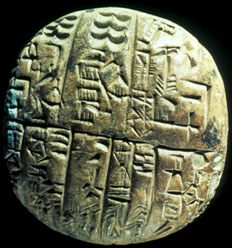Greek Resources
Cuneiform Tablets
The system of writing known as “cuneiform” involved symbols formed by pressing strokes into wet clay with a reed whose end had been cut into a wedge-shape. The name comes from the Latin word cuneus which refers to almost anything in the shape of a wedge: literal wedges, troops drawn up in a wedge-shaped formation, the wedge-shaped division of rows in a theater, etc.
The tablets on this page were discovered in 1975 in the archives of an administrative palace complex at Ebla and have been dated to c. 2600-2300 B.C. The archives contained over 17,000 clay tablets written in a Semitic language and containing mostly administrative records. The tablets were stored on wooden shelves and sometimes in baskets, and have survived only because the palace was destroyed by a great fire which baked the clay.

Square tablets like this one typically contain lists of inventories. Each entry is enclosed in a box, with the boxes set in columns (to facilitate totalling at the end).
This tablet measures 7.5 x 6.7 inches.

Short business transactions were recorded on small rounded tablets, with the same division into blocks as above. Indented circles (top) & semicircles (lower left) represent numbers based on a unit of 60.
[source: Biblical Archaeology Society; Marie-Henriette Gates]





